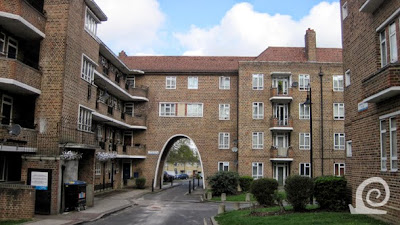As the endless repetition of semidetached housing in
various vernacular styles or pastiche architecture along similar after similar
street in suburban London clearly shows, the basically conservative nature of
middle-class Brits has left little room for experiment or anything more than
conscious variation on a well-defined theme. The English disdain for
multi-storey living has been well-documented. This is in part the reason for
continental European ideas not being taking up in Britain prior to the 1950s.
So any complex inspired by Viennese examples of compact modernist social
housing generated much excitement and it still does!
Somers Town was developed in the 19th century from
market gardens into a northern extension of the sprawling London Metropolis by
the owner of the landholding Charles Cocks, Baron Somers of Evesham. The
private developers chose a grid layout of long streets. Somers Town was ,
however, to change forever with the arrival of the railways as it became
sandwiched between Euston Station (1838) in the west and St Pancras Station
(1868) and King's Cross Station (1852) in the east. St Pancras Old Church still
stands in isolation along the train tracks behind the eponymous station
buildings.
The massive wave of building after WW1 took place
mostly along the lines of garden suburb developments. The so-called cottage
estates planned and designed by the London County Council are an example of
this. In Britain even the Labour Movement believed that the working classed
were best served with houses with gardens. This is in sharp contrast to the
forward-thinking ideals of continental socialists who advocated modern and airy
living with shared facilities and communal gardens. Thus in countries like
Germany, Belgium, the Netherlands, Denmark, Austria and Finland cost effective
ways of providing low-rent accommodation were found in building small en large
housing complexes with communal amenities, especially after 1918. There are
however some experiments towards modern living for the masses from about 1900.
How bold a step was it therefore when George Topham
Forrest was asked to design a new housing estate for the displaced residents of
the former inner-city slums that were cleared by the LCC, that he would propose
a multi-storey mixed-use redevelopment of the 2.2 hectare site in Somers Town.
The architect concluded that the small site required building upwards of the
usual 5 storeys. In his initial plans (1925) he envisaged a functional plinth
with ground-floor shops and first-floor offices with 2 floors of spacious middle-class
apartments above that and another 7 floors of smaller labourers apartments
above them. He had no socialist ideals
on mixing social classes with his scheme, but looked at the site with great
practicality. His proposals were turned down by the LCC, as they would require
the incorporation of lifts.
After a visit to Vienna, Topham Forrest amended his
plans. In 1927 he presented his new designs for the Ossulston Estate clearly
inspired by Viennese examples such as the Carl Seitz Hof and the Karl Marx Hof.
His crucial modification was to create a staggered roofline by alternating
sections of 3 storeys with sections of 6 storeys and towers of 9 storeys. The
way he included shops on one side always near the entrances to the inner court
yards reflects the Carl Seitz Hof (or Garden City Floridsdorf as it was known
then). By snaking the apartments in between communal courtyard he gave the
residents the greatest possible supply of air and light. Each apartment also
had a small balcony overlooking one of the courtyards. In German, Dutch and
Austrian examples of such Super Blocks the courtyards are laid to grass or
planted with flowers and trees. The Ossulston estate would provide
accommodation for some 3050 people in 492 flats.

The Super Block Estate sits between Euston Station (1)
and The British Library (5) in Somers Town that was changed beyond recognition
by the railways, as this picture makes clear. The old roads have been projected
over the large current station buildings of St Pancras (2), King's Cross (3),
St Pancras International (6) and the King's Cross expansion (7). The Town Hall
of Camden (4) was built opposite Euston Square, once a lovely garden square.The
Ossulston Estate (A) follows the direction of the old grid. St Pancras Old
Church (B) stand at some distance along the now covered Fleet river (C). The
Octagon (D) and part of St James Graveyard (now St James' Gardens -E) have also
disappeared.
The estate has been extensively restored with some
greenery added to the barren paved courtyards. This, however, should ideally be
expanded to better the visual appeal and increase the well-being of residents.
The complex remains a rare example of a multi-storey residential development from
the 1920s in an expressive modern style of architecture.



















